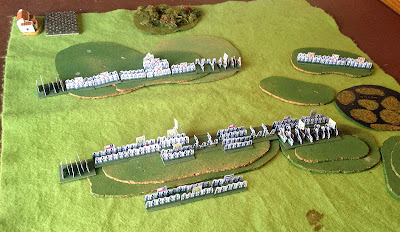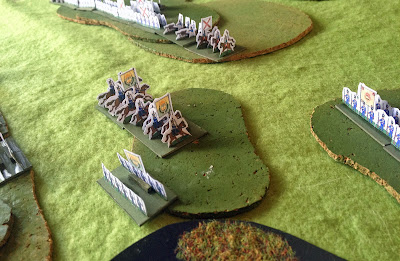What I'd like is a system which still makes use of the Political Tokens, but uses them as part of the route to victory, rather than them being the direct cause.The idea I am looking at at the moment is Proclamations.
Firstly, a summary of two mechanisms in use in the campaign - Demoralisation Points and Political Tokens.
Political Tokens
Each player starts with two Political Tokens. Two more Political Tokens are placed in the centre of the table as Uncontrolled.
After a battle, the winner can make one political action.
An action can be:
- Pick up a single uncontrolled Political Token from the centre of the table, adding it to their own collection. No roll is required for this.
- Force their opponent to put one of their tokens into the centre of the table. This succeeds on a D6 roll of 4 or less.
- Seize one of their opponents’ political tokens and add it to their own pile. This succeeds on a die roll of 2 or less.
The current victory conditions are that you win if your opponent has no tokens. Obviously if they win a battle and take an uncontrolled token, you would then have to win at least three battles against them to strip them of their controlled tokens.
Demoralisation Points
After a battle, one or both sides may gain or lose Demoralisation Points. The lowest score you can have is 0. After a battle, check the element loss differential:
1-2 Winner -1 DP, Loser +1DP
3-4 Winner -2DP, Loser +1DP
3-4 Winner -2DP, Loser +1DP
5+ Winner -2DP, Loser +2DP
At the start of each battle both players roll a D6. On a score equal to or less than your current DP you have a break-point of only 4 elements (8AP). Otherwise your breakpoint is 6 elements (12AP). Not that both armies could have a break-point of 4 elements.
With those two rules in mind, this is how I now see victory working in a campaign:
Proclamations
At the end of the Political phase of the turn, the side that won the battle may choose to make a Proclamation in order to win the campaign. At least two battle must have been fought - no Proclamation can be made after the first battle, regardless of the result.
The side making the Proclamation adds the number of Political Tokens they control to their opponent's Demoralisation Points. From this total they subtract the number of Political Tokens their opponent controls and the number of Proclamations they have already made. This gives the side's Political Capital.
For a Proclamation to succeed, roll equal to or less than the Political Capital on a D6. A roll of '6' is always a failure. If the Proclamation succeeds, then you have won the campaign, otherwise proceed to the next battle.
Example: In the campaign I played yesterday the situation after the second battle was:
Royalists - 2 Political Tokens, 0 Demoralisation Points
Patriots - 0 Political Tokens, 3 Demoralisation Points
Patriots - 0 Political Tokens, 3 Demoralisation Points
The Royalists won the second battle, so could make a Proclamation. Their Capital is 2 (Own Political Tokens) + 3 (Opponent's Demoralisation) - 0 (Opponent's Political Tokens) = 5. To succeed they would have had to roll a 5 or less on a D6.
By my reckoning this system should run a campaign to about 3-5 battles, which is enough for anyone.
Thoughts and comments are welcome.



















































